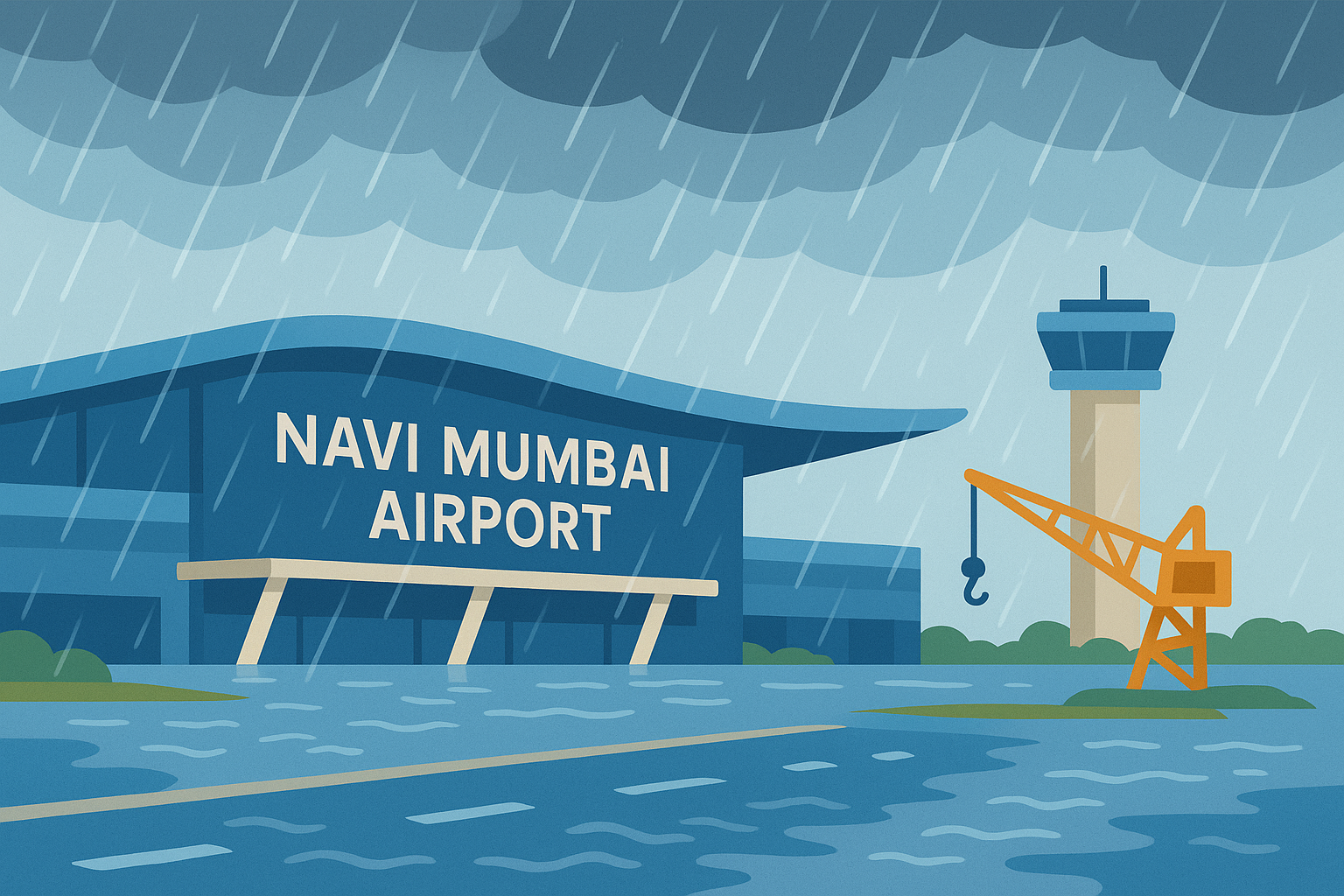
Navi Mumbai Airport Inauguration Postponed Due to Heavy Rains, New Date Likely in October
Mumbai/Navi Mumbai: The much-anticipated inauguration of the Navi Mumbai International Airport (NMIA), scheduled for September 30, has been postponed due to heavy monsoon rains that lashed Mumbai and the Konkan region. The decision was taken after concerns were raised about accessibility to the new airport site in Ulwe, where loose soil and muck on approach roads could pose challenges for visitors.
Prime Minister Narendra Modi, who was expected to inaugurate NMIA, will now attend the ceremony in October, officials confirmed. Alongside the airport launch, Modi was also set to inaugurate the final stretch of Mumbai Metro Line 3 (Worli to Cuffe Parade), which has also been deferred to a later date.
Why the Delay?
An official from the Maharashtra Chief Minister’s Office explained that continuous rains had left the approach roads unstable. “There is a lot of loose soil and muck on the roads leading to the airport, which may create difficulties for dignitaries and guests reaching the site,” the official said. The Prime Minister’s Office (PMO) conveyed its decision to the state government two days ago, pushing the airport inauguration to October.
Despite the delay, preparations for commercial operations remain on track. Several airlines, including IndiGo, Akasa Air, and now Air India, have confirmed their plans to launch flights from NMIA once it becomes operational.
Air India Joins IndiGo and Akasa in NMIA Plans
On Tuesday, Air India announced that its low-cost carrier Air India Express will begin services in NMIA’s first phase. The airline plans to operate 20 daily flights connecting 15 Indian cities and expand to 55 departures, including up to five international flights, by mid-2026. By winter 2026, the number is expected to rise to 60 daily flights.
Air India CEO and Managing Director Campbell Wilson said,
“We look forward to commencing operations at Navi Mumbai International Airport, as Mumbai joins the league of world cities with more than one airport. NMIA will not just connect India but serve as a global transit hub, thanks to its strategic location.”
Earlier this year, IndiGo announced it would start with 18 daily flights to 15 destinations and scale up to 140 daily flights—including 30 international services—within 18 months. Akasa Air also confirmed plans to launch 15 domestic flights daily at the start, with ambitions of operating 300 domestic and 50 international flights per week in the future.
A Second Major Airport for MMR
The Navi Mumbai International Airport is being developed under a public-private partnership (PPP) led by Adani Airports. Built in five phases, the airport will complement Mumbai’s overburdened Chhatrapati Shivaji Maharaj International Airport (CSMIA).
- Phase 1: Opening in late 2025, it will handle 20 million passengers and 500,000 metric tonnes of cargo annually.
- Full Capacity: Upon completion, NMIA will manage up to 90 million passengers and 3.2 million metric tonnes of cargo annually, making it one of India’s largest aviation hubs.
Connectivity Boost: Metro 8 and Rail Expansion
To strengthen last-mile access to NMIA, multiple infrastructure projects are being fast-tracked.
Mumbai Metro Line 8 – The Gold Line
The City and Industrial Development Corporation (Cidco) has floated a tender for consultants to review the Detailed Project Report (DPR) of Metro Line 8. Also called the Gold Line, this high-speed metro will connect CSMIA (Mumbai Airport T2) with NMIA.
- Length: 34.9 km
- Cost: Estimated ₹20,000 crore
- Route: Begins at CSMIA T2, runs underground for 9 km, then elevated along the Sion-Panvel Highway, passing through Kurla, LTT, Mankhurd, Vashi, Nerul, and Belapur before reaching NMIA.
- Capacity: Projected to carry 900,000 passengers daily.
- Timeline: DPR review to finish by late 2025, construction to begin mid-2026, with full operations expected by 2028–29.
Cidco Vice Chairman and Managing Director Vijay Singhal highlighted that beyond airport connectivity, Metro 8 will serve as an east-west transit corridor, linking high-density residential and commercial areas while boosting Navi Mumbai’s economic growth.
Nerul/Belapur–Uran Rail Corridor
Central Railway (CR) is also expanding suburban rail services to enhance NMIA connectivity.
- Currently, the 27-km corridor operates 40 daily services.
- From October, 60 daily services will run—a 50% increase—with reduced wait times of up to 15 minutes.
- Two new stations, Targhar and Gavhan, are nearing completion (90% done). Targhar station, the closest to NMIA, will provide vital last-mile access to the airport.
A CR official said, “This expansion will help passengers as NMIA’s first phase nears launch. If required, the number of services can be doubled in the future.”
Looking Ahead
While the inauguration has been temporarily delayed, aviation experts believe the postponement will not affect NMIA’s operational timeline. With airlines confirming flight schedules and infrastructure projects gaining speed, the new airport is on course to transform Mumbai’s air travel landscape.
Once operational, NMIA will not only ease congestion at CSMIA but also position Navi Mumbai as a major aviation and commercial hub, strengthening India’s standing as a global travel and trade destination.




